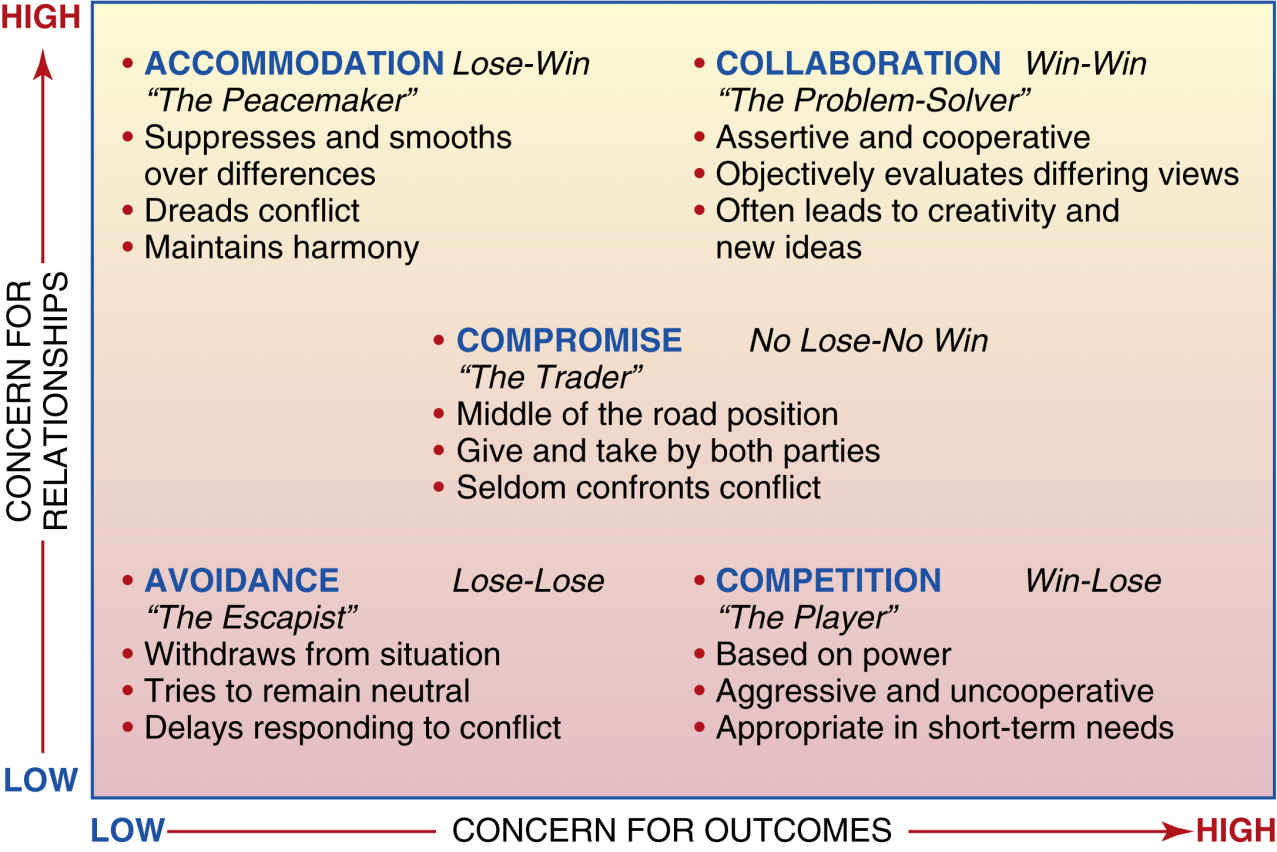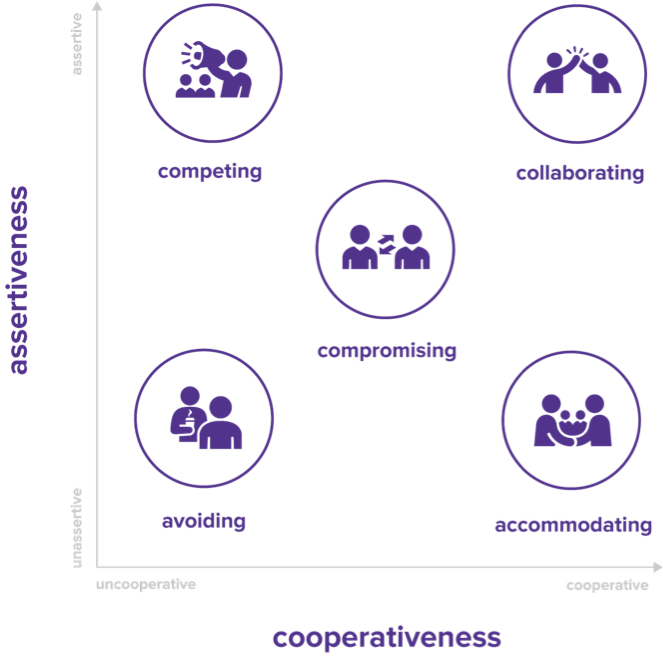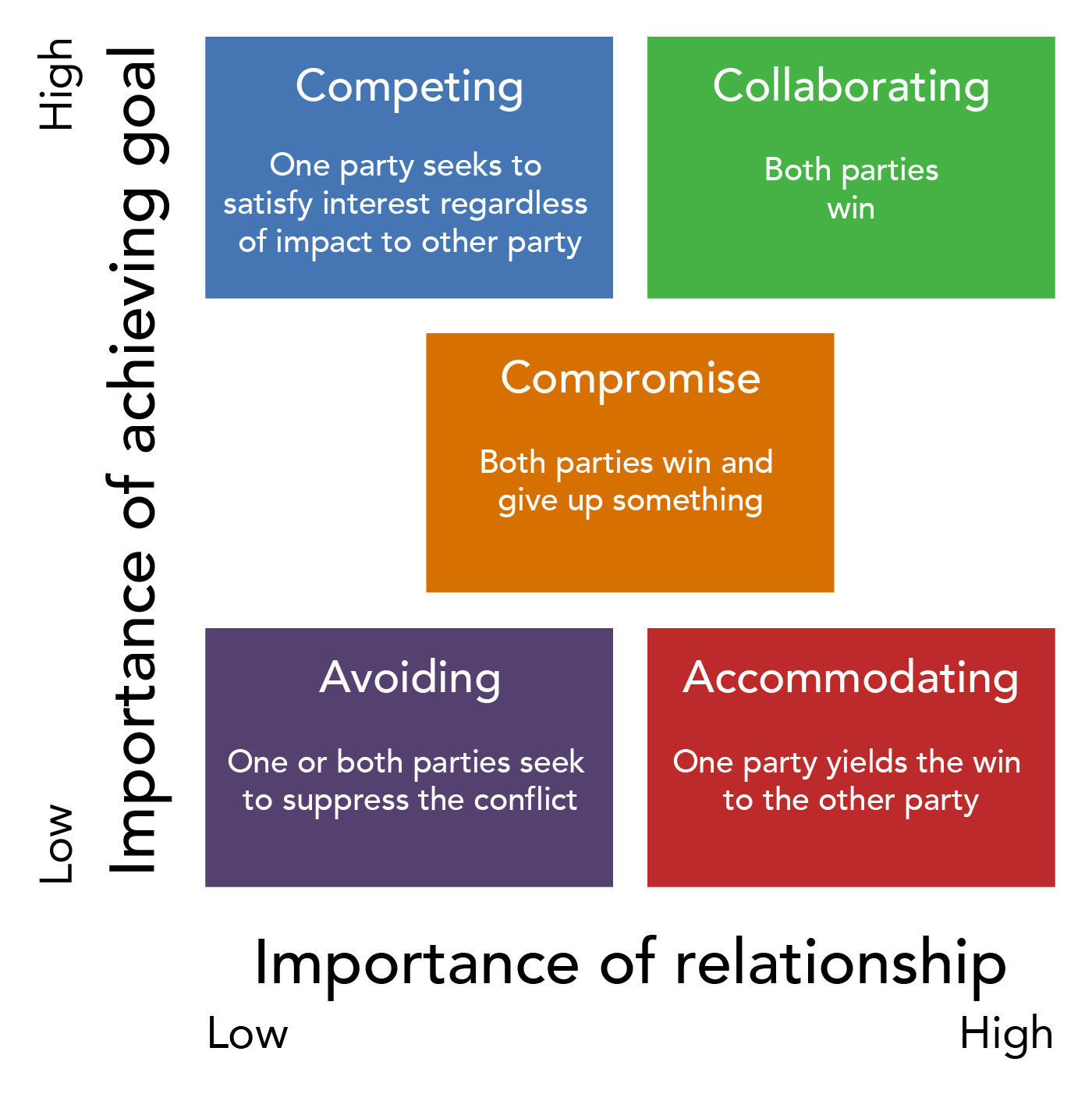Describe the Competitive Style of Conflict
The goal to avoiding conflict is to avoid making a decision so that neither your concerns nor the concerns of the other party are satisfied. For accommodating style negotiators the relationship is everything.
A compromising conflict management style tries to find a way to partially satisfy people on both sides of the argument.

. A zebra may choose a cooperative or competitive style like the dolphin or lion depending on the situation. A competing style -- high on assertiveness and low on cooperativeness. The collaborating style is best used when you care more about the relationships.
In 1987 Delta Airlines offered triple miles to any passenger who charged their tickets on their American Express Card for all of the year of 1988. An avoiding style -- low on both assertiveness and cooperativeness. Conflict is often best understood by examining the consequences of various behaviors at moments in time.
The conflict can be won by any means necessary. There are five conflict management styles as follows. Restate your position firmly using strong language not wed like or want but rather.
Avoiding - Turtle People who chose the avoiding style do not get involved in a conflict. This is a power-oriented mode in which you use whatever power seems appropriate to win your own positionyour ability to. An accommodating style -- low on assertiveness and high on cooperativeness.
The collaborating style of conflict management prioritizes the relationship over the outcome. The competing style of conflict management addresses conflict directly as the goal of the competing style is to end the conflict as quickly as possible. When Conflict Gets Out of Control.
The conflict style profiles developed by Kenneth W. Individuals with competitive styles stand firm on their decisions when the decision is an unpopular one. The 5 conflict management styles.
The competing conflict management style is an aggressive action-driven approach that provides one party with what they want while the other party does not get what they want. - When reaching a solution is more important than the solution itself. An accommodating negotiating style follows the I lose you win model which does not seem to be in a negotiators best interest.
Competing collaborating avoiding accommodating and compromising. A person choosing the avoiding style might say You decide and leave me out of it. When to use it.
Argument rank position or authority or a political exercise of power. We require or need and never reward bullies. Competitive style is when ones own needs are advocated over the need of others.
Adjustments are made on both ends to resolve the conflict at hand. A competitive style negotiator will see you as weak and come back for more. Accommodate I Lose - You Win The opposite of competing.
Each style is a way to meet ones needs in a dispute but may impact other people in different ways. Experts in conflict resolution say people tend to have a default style a preferred approach that typically we rely on. - When you need a temporary solution.
Thomas and Ralph H. We have also added examples from an imaginary scenario to help you better understand each conflict style. Styles of Conflict Management and their Representative Animals.
Often called the win-lose approach this conflict management style results in one party having their wants and needs met while the other does. However a zebra may not choose a compromising style for all things. While the competing style may get fast results it can also be detrimental to the morale and productivity of a team.
The Thomas-Kilmann Conflict Mode Instrument identifies five conflict styles - competing compromising collaborating avoiding and accommodating - and provides guidelines regarding when each is appropriate in conflict situations. According to two researchers Thomas and Kilmann we can identify five conflict-handling styles. Critical Thinking Questions 1.
For example when you want to just make a decision and move on to more important. A competing style is one in which the concerns and the position of the opposition are completely ignored. The airline businesses continued this escalating negotiation competitive style through the early 1980s as each airline tried to outdo its competitors.
Describe the competitive style of conflict. The pros of this are that you gain a quick solution and maintain your self-respect and self-esteem when youre persistent with your beliefs. Describe an avoiding conflict style.
These behaviors are usefully categorized according to conflict styles. The Use and Misuse of a Competing Style in Conflict Management. Conflict management styles quiz.
This style aims to find an expedient mutually acceptable solution that partially satisfies both parties in the conflict while maintaining some assertiveness and cooperativeness. Here are five styles drawn from the work of conflict scholars. Competition Most of the time competition is associated with negative effects and emotions such as stress and anger negativity and harmed relationships Bergman.
Since you are so firm in your own beliefs and often ignore the beliefs of others you might find yourself taking on a Competing style. TJs will likely approach a Competing conflict management style. Winning the argument is the only metric and any concession to the other side is seen as a sign of weakness.
This style is best to use when the outcome is not crucial and you are losing time. They often have a firm idea of what they want to see happen and they will fight to make that happen. To illustrate these styles they selected specific animals because various personality traits can be represented in.
How to manage conflict. Conflict management styles. In conflict resolution avoiding negotiators work best in situations where the investment of time to resolve the issue outweighs the outcome of the discussion.
Competing is a style in which ones own needs are advocated over the needs of. Following is a brief description of each style as explained by the authors of the assessment. The goal is to meet all the needs of all parties involved in the conflict.
A competing style can be effective during certain difficult situations like in a crisis when decisions need to be made immediately. COMPETING is assertive and uncooperativean individual pursues his own concerns at the other persons expense. Researchers have identified five major conflict management styles based on a continuum from assertive competitive to cooperative.
Describe the competitive style of conflict. The Five Styles of Conflict. A competitive style can be perceived as aggressive confrontational and uncooperative.
However the biggest drawback of a competing style is that it can cause harm to relationships sometimes beyond repair.

5 Stages Of Conflict Process How It Works Within Organization

5 Conflict Styles That Every Project Manager Needs To Know Idfive

Conflict Management Styles Organizational Behavior And Human Relations
No comments for "Describe the Competitive Style of Conflict"
Post a Comment